Small overlap front: driver-side
Rating applies to 2018-22 models
Tested vehicle: 2014 Mitsubishi Outlander 2.4 SE 4-door 4wd
The Mitsubishi Outlander was redesigned for the 2014 model year. These ratings also apply to the Outlander PHEV (plug-in hybrid electric) variant, which was introduced in the 2018 model year.
| Evaluation criteria | Rating |
|---|---|
| Structure and safety cage | |
| Driver injury measures | |
| Head/neck | |
| Chest | |
| Hip/thigh | |
| Lower leg/foot | |
| Driver restraints and dummy kinematics | |
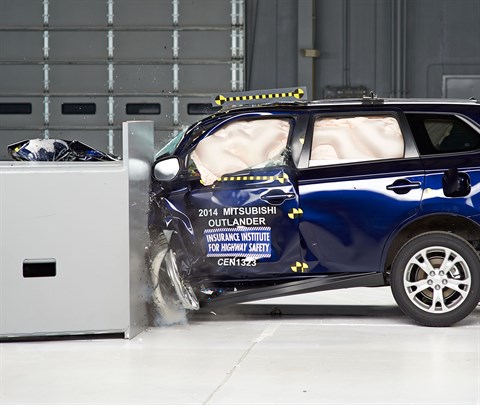
Action shot taken during the driver-side small overlap frontal crash test.

The dummy's position in relation to the door frame, steering wheel, and instrument panel after the crash test indicates that the driver's survival space was maintained reasonably well.

The dummy’s head contacted the frontal airbag but then slid off the left side. The side curtain airbag extended far enough forward toward the A-pillar to protect the head from contact with side structure.
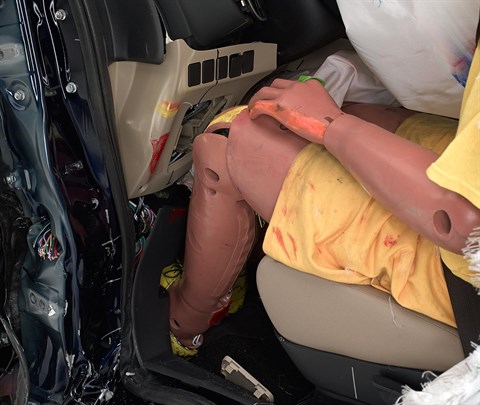
Intrusion into the driver's space was reasonably well controlled, and risk of injuries to the dummy's legs and feet was low.
Small overlap front: passenger-side
Rating applies to 2018-22 models
Tested vehicle: 2018 Mitsubishi Outlander 2.4 ES 4-door 4wd
The Mitsubishi Outlander was redesigned for the 2014 model year. These ratings also apply to the Outlander PHEV (plug-in hybrid electric) variant, which was introduced in the 2018 model year.
| Evaluation criteria | Rating |
|---|---|
| Overall evaluation | |
| Structure and safety cage | |
| Passenger injury measures | |
| Head/neck | |
| Chest | |
| Hip/thigh | |
| Lower leg/foot | |
| Passenger restraints and dummy kinematics | |
| Driver injury measures | |
| Head/neck | |
| Chest | |
| Hip/thigh | |
| Lower leg/foot | |
| Driver restraints and dummy kinematics | |
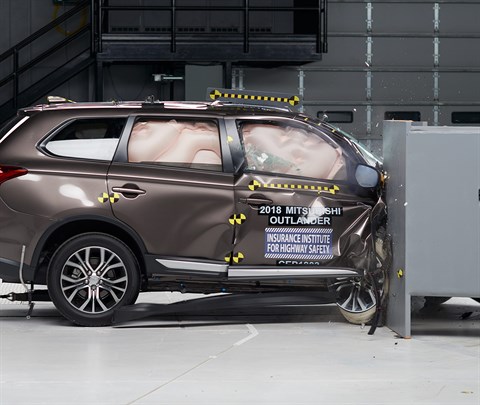
Action shot taken during the passenger-side small overlap frontal crash test.
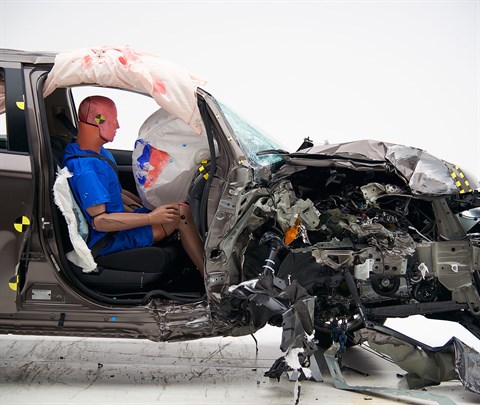
The dummy's position in relation to the door frame and dashboard after the crash test indicates that the passenger's survival space was maintained reasonably well.
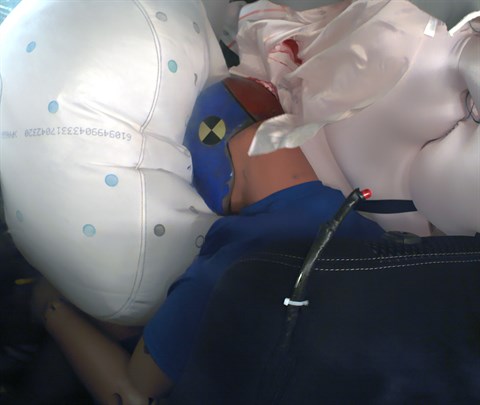
The frontal and side curtain airbags worked well together to keep the head from coming close to any stiff structure or outside objects that could cause injury.
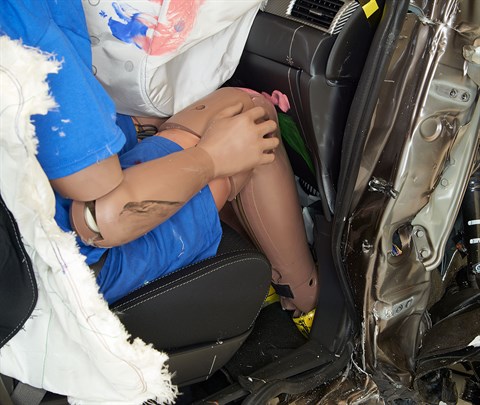
Despite intrusion of the dashboard and door hinge pillar, risk of injuries to the dummy's legs and feet was low.
Moderate overlap front: original test
Rating applies to 2018-22 models
Tested vehicle: 2014 Mitsubishi Outlander 2.4 SE 4-door 4wd
The Mitsubishi Outlander was redesigned for the 2014 model year. Moderate overlap frontal ratings are assigned by the Institute based on a test conducted by Mitsubishi. (The vehicle tested by Mitsubishi was designated as a 2013 model but included all the design changes of the 2014 models.)
These ratings also apply to the Outlander PHEV (plug-in hybrid electric) variant, which was introduced in the 2018 model year.
| Evaluation criteria | Rating |
|---|---|
| Overall evaluation | |
| Structure and safety cage | |
| Driver injury measures | |
| Head/neck | |
| Chest | |
| Leg/foot, left | |
| Leg/foot, right | |
| Driver restraints and dummy kinematics | |
Side: original test
Rating applies to 2018-22 models
Tested vehicle: 2014 Mitsubishi Outlander GT 4-door 4wd with standard front and second row head curtain airbags and standard front seat-mounted torso airbags
The Mitsubishi Outlander was redesigned for the 2014 model year. Side ratings are assigned by the Institute based on a test conducted by Mitsubishi. (The vehicle tested by Mitsubishi was designated as a 2013 model but included all the design changes of the 2014 models.)
These ratings also apply to the Outlander PHEV (plug-in hybrid electric) variant, which was introduced in the 2018 model year.
| Evaluation criteria | Rating |
|---|---|
| Overall evaluation | |
| Structure and safety cage | |
| Driver injury measures | |
| Head/neck | |
| Torso | |
| Pelvis/leg | |
| Driver head protection | |
| Rear passenger injury measures | |
| Head/neck | |
| Torso | |
| Pelvis/leg | |
| Rear passenger head protection | |
Roof strength
Rating applies to 2018-22 models
Tested vehicle: 2014 Mitsubishi Outlander 2.4 SE 4-door 4wd
Rating applies to both the Outlander (tested) and Outlander PHEV (plug-in hybrid electric) versions.
| Overall evaluation | |
|---|---|
| Curb weight | 3,438 lbs |
| Peak force | 17,034 lbs |
| Strength-to-weight ratio | 4.95 |
Head restraints & seats
Seat type: Power leatherette seat
| Overall evaluation | |
|---|---|
| Dynamic rating | |
| Seat/head restraint geometry |
About the head restraint & seat test
Currently, IIHS tests apply only to front seats.
Headlights
Ratings are given for 2 different headlight variations available on this vehicle.
Trim level(s)
- GT trim
| Evaluation criteria | Rating |
|---|---|
| Low-beam headlight type | LED projector |
| High-beam headlight type | LED reflector |
| Curve-adaptive? | No |
| High-beam assist? | Yes |
|
Overall rating | |
| Distance at which headlights provide at least 5 lux illumination: | |
Low beams
On the straightaway, visibility was fair on the right side of the road and inadequate on the left side. On curves, visibility was good on the gradual right curve, fair on the sharp right curve and inadequate on both left curves.
The low beams never exceeded glare limits.
High beams
On the straightaway, visibility was good on both sides of the road. On curves, visibility was good on the gradual right curve, fair on the sharp right and gradual left curves, and inadequate on the sharp left curve.
High-beam assist compensates for some limitations of this vehicle's low beams on the straightaway and all 4 curves.
Trim level(s)
- SEL trim
| Evaluation criteria | Rating |
|---|---|
| Low-beam headlight type | Halogen projector |
| High-beam headlight type | Halogen reflector |
| Curve-adaptive? | No |
| High-beam assist? | Yes |
|
Overall rating | |
| Distance at which headlights provide at least 5 lux illumination: | |
Low beams
On the straightaway, visibility was fair on the right side of the road and inadequate on the left side. On curves, visibility was inadequate in all 4 tests.
The low beams never exceeded glare limits.
High beams
On the straightaway, visibility was fair on the right side of the road and inadequate on the left side. On curves, visibility was inadequate in all 4 tests.
High-beam assist compensates for some limitations of this vehicle's low beams on the straightaway and all 4 curves.
Front crash prevention: vehicle-to-vehicle
Child seat anchors
Rating applies to 2018-22 models
| Evaluation criteria | Rating |
|---|---|
| Overall evaluation | |
| Vehicle trim | SEL |
| Seat type | leatherette |
This vehicle has 2 rear seating positions with complete child seat attachment (LATCH) hardware.
It has 1 additional seating position with a tether anchor only.
| Evaluation criteria | Rating |
|---|---|
| Overall evaluation | |
| Vehicle trim | SEL |
| Seat type | leatherette |
| Rating icon | Rating |
|---|---|
| G | Good |
| A | Acceptable |
| M | Marginal |
| P | Poor |
| Seating positions that rely on borrowed lower anchors or have only a tether anchor available are not rated. | |
thether anchor symbol | Tether anchor |
lower anchor symbol | Lower anchors |
| Lower anchor(s) can be borrowed from adjacent positions(s) | |
| No hardware available |
Details by seating position
| Position | Rating |
|---|---|
| 1 | |
| Tether anchor | |
| easy-to-find location | |
| other hardware could be confused for anchor | |
| Lower anchors | |
| too deep in seat | |
| not too much force needed to attach | |
| easy to maneuver around anchors | |
| 2 | |
| Tether anchor | |
| easy-to-find location | |
| other hardware could be confused for anchor | |
| Lower anchors | |
| none available | |
| 3 | |
| Tether anchor | |
| easy-to-find location | |
| other hardware could be confused for anchor | |
| Lower anchors | |
| too deep in seat | |
| not too much force needed to attach | |
| easy to maneuver around anchors |
